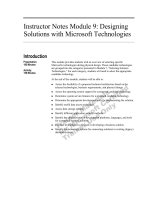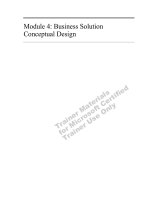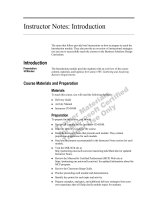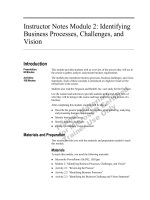Tài liệu Instructor Notes Module 6: Business - Solution Physical Design pptx
Bạn đang xem bản rút gọn của tài liệu. Xem và tải ngay bản đầy đủ của tài liệu tại đây (93.91 KB, 6 trang )
Instructor Notes Module 6: Business
Solution Physical Design
Introduction
In this module, students will learn about the basics of physical design, where it
fits in the Microsoft
®
Solutions Framework (MSF) Process Model, its purpose
and value in solution design, its steps and tasks, and its outputs and
deliverables. Students also learn how the process of developing a physical
design will enable them to deliver solutions that match their customer’s
requirements.
After completing this module, students will be able to:
!
Explain the need for physical design in the process of designing a business
solution.
!
Describe the role of physical design in the MSF Design Process.
!
Describe the steps of physical design.
!
Create a preliminary services topology.
!
Identify the risks in conflicts between solution requirements and physical
constraints.
Materials and Preparation
This section provides you with the materials and preparation needed to teach
this module.
Materials
Provide a checklist of materials that you will need to teach this module,
including the standard course material such as a video or blank disks for
students.
To teach this module, you need the following materials:
!
Microsoft PowerPoint
®
file P06_1608a.ppt
!
Module 6, “Business Solution Physical Design”
!
Activity 6.1, “Risks of Skipping Physical Design”
!
Activity 6.2, “Risks in Constraints and Requirements”
!
Activity 6.3, “Determining a Preliminary Distribution of Services Across a
Network Topology”
Presentation:
85 Minutes
Activity:
40 Minutes
2 Instructor Notes Module 6: Business Solution Physical Design
Preparation
To prepare for this module, you should:
!
Read all the materials for this module.
!
Complete the activities.
Instructor Notes Module 6: Business Solution Physical Design 3
Activities
Activity 6.1: Risks of Skipping Physical Design
In this activity, students will participate in a class discussion to identify the
possible risks are of not completing a physical design in the process of
designing a business solution.
After completing this activity, students will be able to:
!
Articulate the value of doing physical design and the risks of not doing
physical design.
!
To prepare for the activity
1. Complete the activity yourself, thinking through the possible directions that
the discussion may take.
2. Prepare examples from your own experience.
3. Prepare some questions to foster a class discussion.
Activity 6.2: Risks in Constraints and Requirements
In this activity, students will participate in a class discussion about the
implications of the constraints and requirements in the Ferguson and Bardell,
Inc. case study.
After completing this activity, students will be able to:
!
Articulate the type of risks that become evident when requirements are not
aligned with the physical constraints of the solution.
!
To prepare for the activity
1. Review the Ferguson and Bardell, Inc. case study.
2. Create some new requirements and constraints to add to the case study.
3. Complete the activity by using the new requirements and constraints.
Think through possible ramifications of the additional information on the
case study and its solution.
4. Prepare some questions to foster a class discussion.
4 Instructor Notes Module 6: Business Solution Physical Design
Activity 6.3: Determining a Preliminary Distribution of
Services Across a Network Topology
In this activity, students will create a preliminary plan for distributing services
across a network topology.
After completing this activity, students will be able to:
!
Create a service topology by distributing services across the network
topology.
!
To prepare for the activity
1. Prepare extra copies of the business-object model created in Module 5, in
case some students do not have their copy.
You can use either the class consensus business object model or distribute
the one from the suggested solution.
2. Complete the activity yourself.
3. Remind students of the services-based design approach of Module 3.
This approach consists of the user, business, and data services that exist
between the user interface and data store.
Instructor Notes Module 6: Business Solution Physical Design 5
Module Strategy
Use the following strategy to present this module:
!
Physical Design Basics
This section provides an overview of the Physical Design Phase of the MSF
Process Model. Having worked through the conceptual and logical phases,
students may have a “Finally!” attitude to reaching this phase. Help them to
understand that physical design is still not coding, but is the final
preparation to that coding, and that the quality of work they do in this last
design phase will have a direct impact on the coding work itself.
!
Risks of Skipping Physical Design
This discussion enables you to gauge the students’ understanding of the
necessity and benefits of physical design.
!
Physical Design Process
This section provides an overview of the physical design process, including
its place within the MSF Process Model. This section also outlines the steps
and deliverables of physical design.
!
Physical Design Research
In this section, students learn about the research step of physical design.
Emphasize that the step takes the solution requirements and constraints and
identifies the gaps and conflicts between them. Also emphasize that the
project team must consider the current enterprise architecture. This step
must be grounded in reality, with no fudging of either the requirements or
the constraints. Finally, examine the concept of trade-offs, and be prepared
with real-life examples of the various ways of dealing with gaps.
!
Risks in Constraints and Requirements
This discussion will enable you to gauge how well the students understand
the importance of the research step of physical design. Use the discussion to
support the content of the section.
!
Physical Design Analysis
This section teaches students about the analysis step of physical design.
Emphasize that this step delivers proposed topologies and candidate
technologies. In many development projects, such analysis is done in a
fairly informal manner. You should help students understand the necessity
of following a formal, yet flexible, process. Remind them of that the MSF
Design Process encourages traceability throughout the design. Help them to
also understand that at this point, the business and user requirements are still
the primary consideration. Additionally, continue to remind them of the
iterative nature of the design process.
!
Determining a Preliminary Distribution of Services Across a Network
Topology
In this activity, students will develop a preliminary distribution of services
across the network topology from the Ferguson and Bardell, Inc. case study.
This is a fairly simple process of determining where the user, business, and
data services will reside. Because this might seem trivial to some students,
be prepared with questions and options for how the services might be
distributed.
THIS PAGE INTENTIONALLY LEFT BLANK









